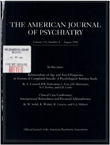Cyclical patterns of states of mind in psychotherapy
Abstract
OBJECTIVE: A quantitative study of shifts in states of mind was conducted to demonstrate a clinically useful mode of observation. This mode categorizes observations of a patient's mental state into well- modulated, overmodulated, undermodulated, and shimmering patterns. METHOD: The authors used reliable systems for scoring a patient's state of mind on videotapes of all sessions of her brief psychotherapy and, using separate procedures, scored the topics of discourse. These data were then examined by means of a lagged log-linear sequential analysis for patterns of shifts from one state to another and for concurrent shifts in topics. RESULTS: The findings indicated nonrandom shifts in state. Patterns of shifting from a well-modulated state to alternative states and back again were overrepresented. Such shifts were related to conflictual topics of discourse. CONCLUSIONS: Observing such shifts in mental state may help psychotherapists to formulate the contents of conflict and also to make technical interventions to stabilize optimal states for doing the work of psychotherapy.
Access content
To read the fulltext, please use one of the options below to sign in or purchase access.- Personal login
- Institutional Login
- Sign in via OpenAthens
- Register for access
-
Please login/register if you wish to pair your device and check access availability.
Not a subscriber?
PsychiatryOnline subscription options offer access to the DSM-5 library, books, journals, CME, and patient resources. This all-in-one virtual library provides psychiatrists and mental health professionals with key resources for diagnosis, treatment, research, and professional development.
Need more help? PsychiatryOnline Customer Service may be reached by emailing [email protected] or by calling 800-368-5777 (in the U.S.) or 703-907-7322 (outside the U.S.).



